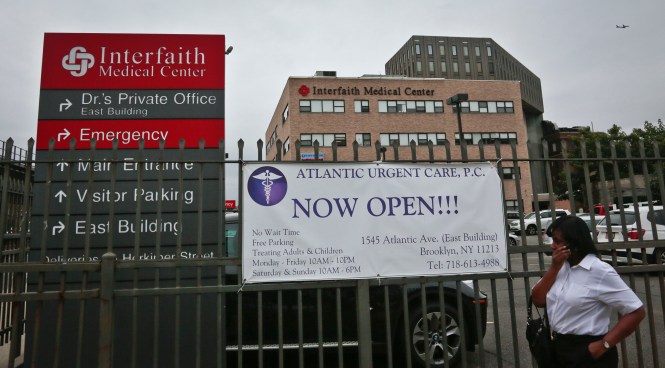Editor’s Note: We reserve the right to place our heading in the lead to any post submitted by a member of the public. In any event we always print the suggested post albeit in a different location. In this event the above title suggests a potential need for hospital consolidtion.
NYC Losing Small Hospitals as Money Woes Mount
Since 2000, 19 hospitals across the city have closed due to financial pressures, and nos. 20 and 21 are underway
By David B. Caruso
NBC News New York
AP
A banner announcing a new urgent care facility at the Interfaith Medical Center hangs on a fence outside the emergency center in New York on Thursday, July 25, 2013. Interfaith, which serves an overwhelming low-income population in Bedford-Stuyvesant, is the second Brooklyn hospital, along with Long Island College Hospital, facing possible closure and bankruptcy proceedings.
Since 2000, 19 hospitals across the city have closed due to financial pressures, and nos. 20 and 21 are underway.
It’s part of a long-simmering trend in health care, experts say: Small, independent hospitals, especially those that serve the poor, are finding it hard to pay the bills.
They continue to lose better-paying patients to big, prestigious medical centers. Revenue from government health programs like Medicaid has gotten smaller. And the political will to bail out struggling facilities has dried up, due partly to a new thinking that in an era of outpatient care, hospital beds just aren’t as important as they once were.
“What you are seeing are tough issues of change in New York,” said James Tallon, president of the United Hospital Fund, a charity focused on hospital philanthropy. “The big picture here is a health care system that is less hospital-dependent.”
He and other observers of the changes unfolding in New York and other older metropolitan areas around the U.S. said the country may be moving deeper into an age where the sickest patients in need of the most sophisticated (and, for hospitals, most lucrative) care are treated mainly in huge medical centers, and many community hospitals are replaced by health clinics or downsized into stand-alone emergency rooms or ambulatory surgical centers.
Whether that will turn out to be bad, good, or neutral for patients remains to be seen.
Some experts worry that industry consolidation will lead to a lack of competition, which will drive up costs. Others said the danger could come if the hospital closures lead to further erosion of other types of medical services, like primary care, in the neighborhoods they once served.
“You can look at many cities, and already there are growing medical deserts,” said Alan Sager, a professor of health policy at Boston University who studies hospital closings.
He noted that the decline in hospital beds also comes just as the baby boom generation has begun to age into the years when they are most likely to need hospital care. The population over age 65 is expected to double over the next five decades.
“We may look back in 10 years and say, ‘How could we not have seen this coming?'” Sager said. “Keeping open a hospital today is going to cost a lot less than rebuilding at $3 million a bed.”
New York’s two latest casualties are Interfaith Medical Center, a bankrupt hospital that served mostly poor patients from Brooklyn’s Bedford-Stuyvesant and Crown Heights sections, and Long Island College Hospital, which sat amid multimillion-dollar brownstones in one of Brooklyn’s wealthiest neighborhoods but struggled to complete with the world-renowned medical centers in Manhattan.
Both have been losing money for years and have gone through ill-fated attempts to save themselves by merging with other facilities or affiliating with hospital systems with deeper pockets.
Health care officials are also nervously eyeing several other city hospitals bleeding red ink. Brooklyn’s Brookdale Hospital Medical Center, which employs more than 3,600 people, lost more than $50 million in 2011. Wycoff Heights Medical Center lost $12.3 million.
Kenneth Raske, the president and CEO of the Greater New York Hospital Association, which keeps a tally of the closings, said the struggling hospitals tend to serve mostly people who have no insurance or those in the federal Medicaid or Medicare programs.
Starting on Oct. 1, many U.S. hospitals will see reimbursement rates decline because of provisions of the Affordable Care Act.
“That could literally be the final nail in the coffin, not just in New York but in other institutions around the country,” Raske said, though he added that some of that lost revenue could be made up if the new federal health overhaul law helps more people obtain insurance.
Gov. Andrew Cuomo has asked federal government for a waiver that would allow New York to use up to $10 billion in expected costs savings from Medicaid reforms on initiatives intended to address the shifts in the health care landscape.
The administration says part of that money would be used to create of more primary care facilities in communities that now rely too much on hospitals to treat chronic illness that probably could be avoided if people had easier access to a regular family doctor. Another initiative would provide money to hospitals looking for ways to reconfigure their services.
Raske said the waiver could be “a way out of the desert” for some medical centers that urgently need to reinvent themselves.
“Hospitals have to transform themselves … but they need seed money to do it,” he said. “Because we are within a baby’s breath of having a significant underserved population



